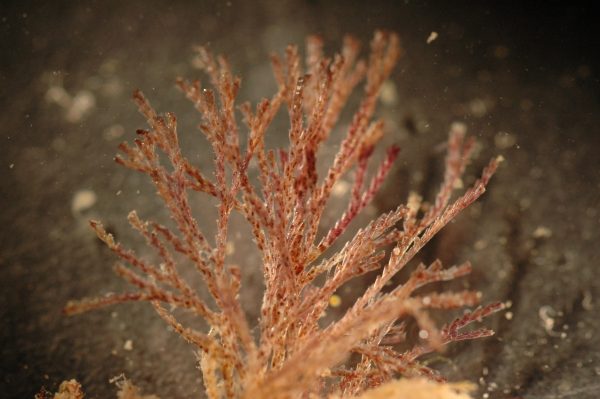New ocean invader spotted in Alaska
October 8, 2018
Paula Dobbyn
907-274-9698

Scientists and local volunteers have detected a new invasive species in the waters of Southeast Alaska.
Alaska Sea Grant’s Gary Freitag, Marine Advisory agent in Ketchikan, is a member of the scientific team that discovered Bugula neritina, an invertebrate filter feeder also referred to as a branching bryozoan. These tiny organisms form colonies and are sometimes called moss animals or sea lace.
“They’re very aggressive. They have the potential to rob native species of food and oxygen. Some marine invasive species, such as colonial tunicates, have been known to wipe out shellfish beds, killing valuable species like oysters and clams,” said Freitag.
The scientific team included researchers from the Smithsonian Environmental Research Center, Temple University and the University of Alaska Fairbanks College of Fisheries and Ocean Sciences. Alaska Sea Grant is housed within UAF and is a partnership with the National Oceanic and Atmospheric Administration.
Beside Bugula neritina, the scientific team documented the continuing spread of three other non-native species in the Ketchikan region. The other invaders are tunicates, invertebrates often called sea squirts. Two of these tunicate species, the golden star and chain tunicate, appear to be spreading in waters around Ketchikan at the southern end of Alaska’s panhandle.
The findings were published last month in Bioinvasions Records, a peer-reviewed, international academic journal.
Marine invasive species are a threat to Alaska’s fishing, aquaculture and tourism industries, as well as to cultural and traditional activities such as subsistence shellfish harvesting.
The recent discoveries of Bugula neritina and invasive tunicates marked the culmination of years of observation not only by professional scientists like Freitag, but also by Ketchikan-area volunteers. In 2003, a group of Smithsonian scientists conducted an initial survey of Ketchikan and noticed the chain tunicate. Four years later, a citizen-science monitoring program called Plate Watch got started. Citizen scientists — including a teacher and students from a nearby high school — have documented the chain tunicate’s spread ever since.
The invasive species are thought to have arrived in Alaska by vessel traffic. Ketchikan is the first stop in Alaska for large, foreign-flagged cruise ships as well as other marine vessels, such as barges and fishing vessels, heading north.
“Vessel traffic is increasing in Alaska. These ships and boats can carry organisms from foreign ecosystems into Alaska waters, where they have the potential to cause significant problems,” said Freitag.
Making the public aware of the growing presence of marine invasive species is the first step toward curbing the problem. Climate change and warming ocean temperatures are likely to exacerbate the issue, making the need for increased citizen monitoring that much more urgent, he said.
The journal article can be found here. Downloadable images and captions can be accessed here.
ADDITIONAL CONTACT: Gary Freitag, 907-617-8990, gary.freitag@alaska.edu
ON THE WEB: http://alaskaseagrant.org


